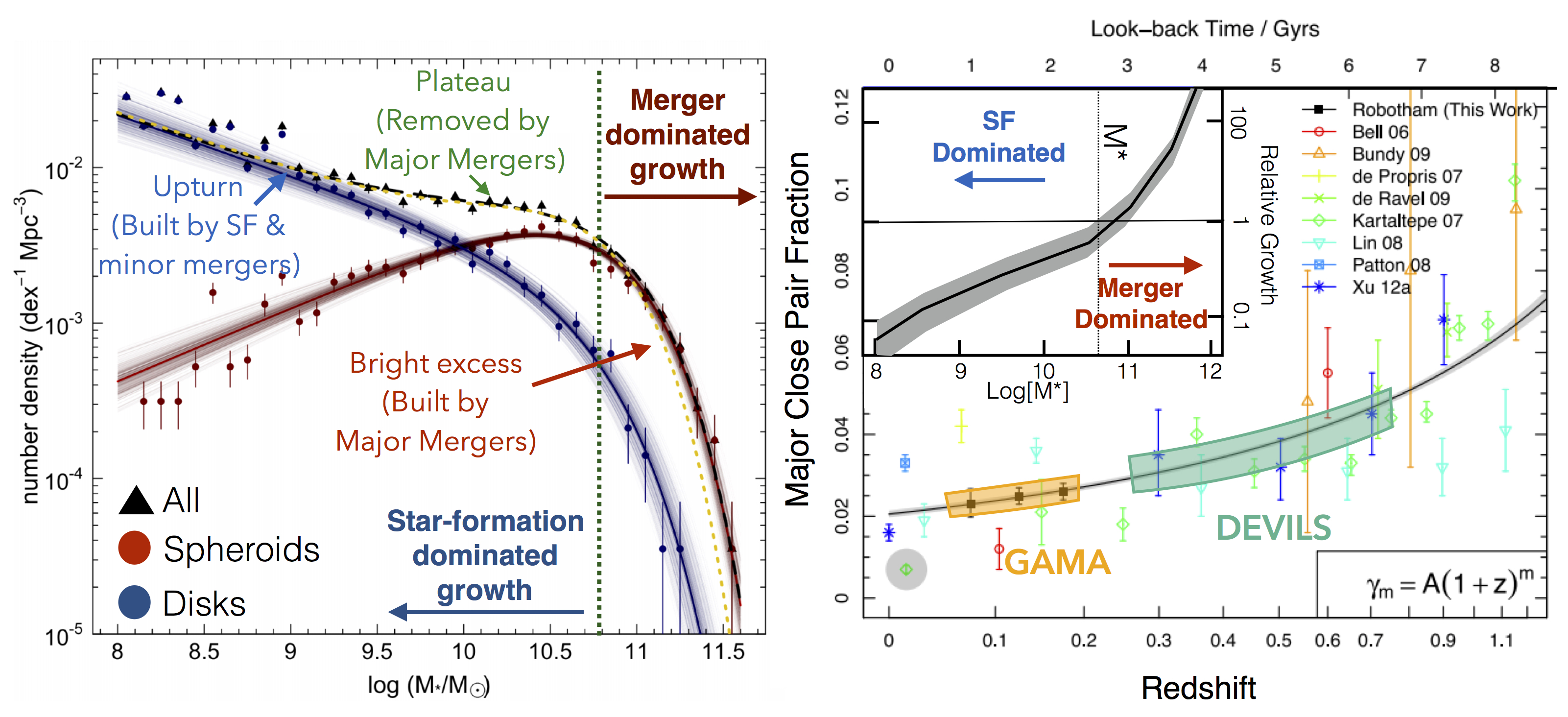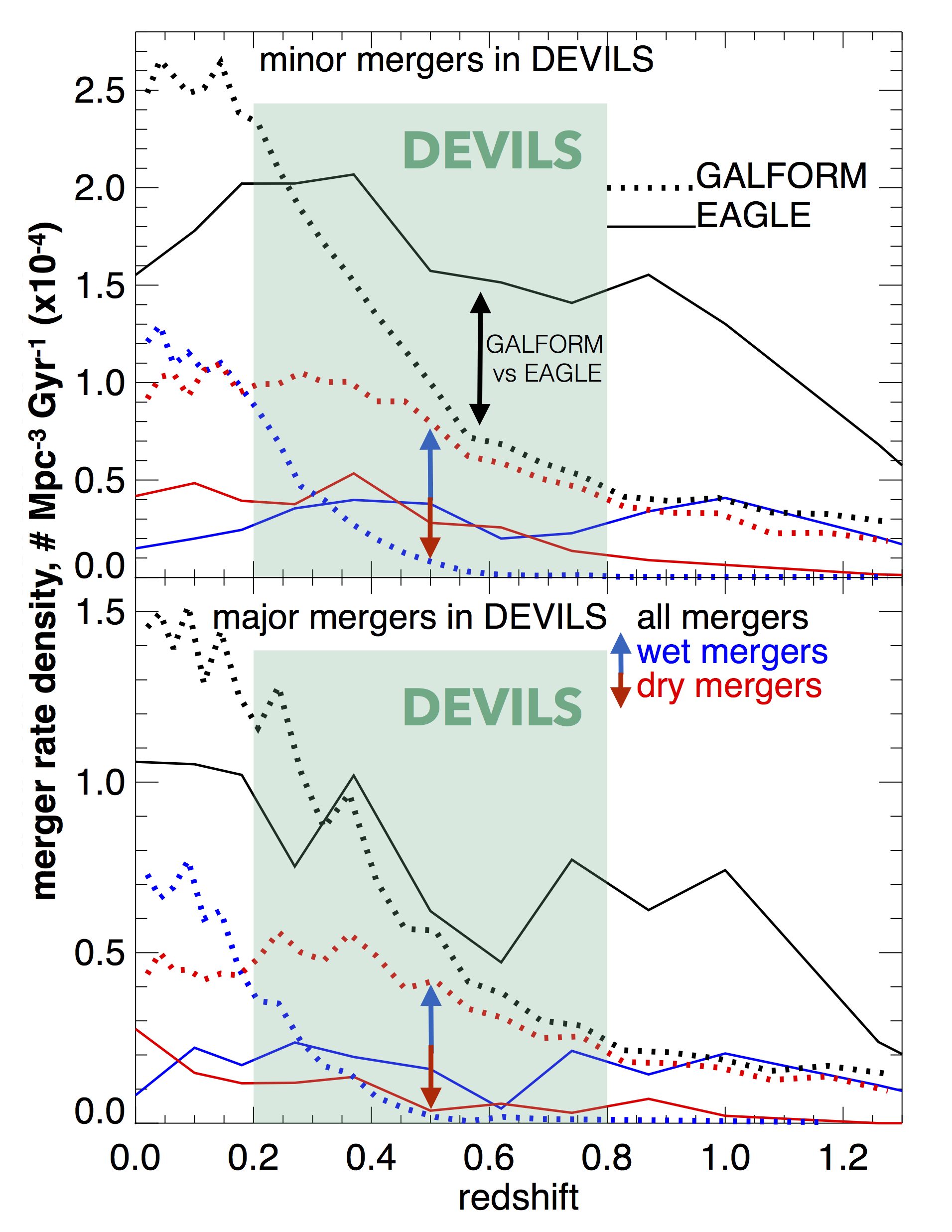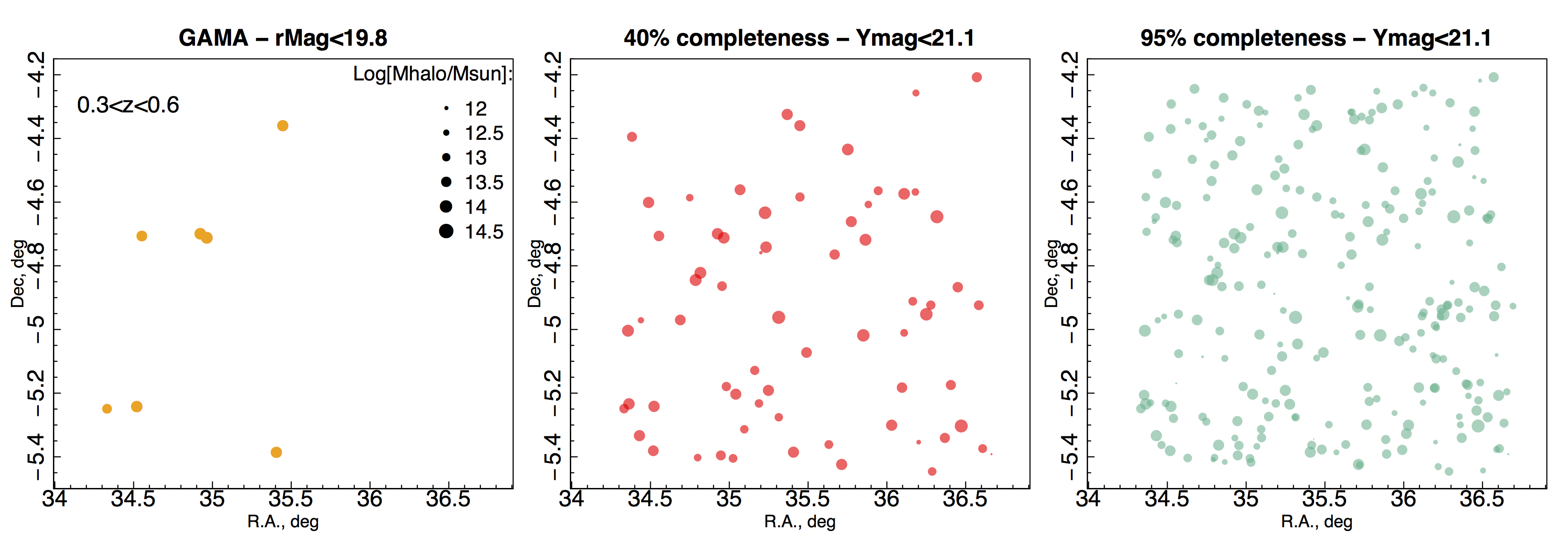The influence of multi-scale environment on galaxy evolution at z > 0.3
One of the most fundamental questions in astrophysics is what processes shaped the galaxies we observe today? To answer this question we typically use two complementary methods; either probing the factors which affect the growth of individual galaxies as a function of stellar mass, environment, epoch, etc, or by measuring the global evolution of the ensemble galaxy population via distributions such as the stellar mass function (SMF) or cosmic star-formation history (CSFH). It is the former of these methods which ultimately probes the processes which shape the latter. As such, we would ideally like to target both the underlying astrophysics and the fundamental relations which they produce. To date, we have exquisitely probed these global relations in the local Universe (e.g. Baldry et al., 2012, Moffett et al 2016, Davies et al., 2016b), and also have some understanding of how the distributions vary with time (e.g. Behroozi et al., 2013, Madau & Dickinson, 2014) and environment (e.g. McNaught-Roberts et al., 2014; Eardley et al. 2015). However, the underlying astrophysics involved in shaping these distributions at each epoch/environment are far from clear. It is not the processes occurring today which produce these relations, but the factors which drove galaxy evolution over the preceding 10 billion years.
Measuring the underlying factors which govern the growth of galaxies is problematic. To first order, there are two dominant mechanisms that drive galaxy evolution: mergers (e.g. Robotham et al., 2014) and star formation (SF, e.g. Kennicutt & Evans., 2012). However, secondary effects such as AGN (Kauffmann et al 2004), gas supply (Tacconi et al 2013), and local (Davies et al., 2015b) and large-scale (Peng et al., 2010) environment also have a significant impact on the evolution of galaxies. It is the varying contribution of these processes over the history of the Universe that lead to the relations we observe today (e.g. Fig 1 – left). Thus, if we wish to understand what shapes the z ∼ 0 fundamental relations, we must probe the relative importance of these underlying processes over cosmological timescales.
Star Formation, Mergers and the Growth of Stellar Mass
In the very local Universe we have begun to explore how mergers and SF are changing the distribution of stellar material at the current epoch (Fig 1 – left). In Robotham et al. (2014) we determined robust merger rates for GAMA (Fig 1 – right), and estimated the relative contribution of SF and mergers in shaping the z ∼ 0 SMF, highlighting that M∗z=0 represents an important transition between merger- and SF-dominated growth (Fig 1-right inset). However, we know very little about how these relative contributions evolve with redshift. This is significant as it is the interplay of mergers and SF at earlier times which ultimately leads to the distribution of galaxies we observe today. For example, we know that both SF and merger rates increase with look-back time (e.g. Lotz et al 2011, Lee et al 2015), but does the relative stellar mass growth via these mechanisms evolve consistently? And can their relative contribution account for the evolution in the shape of the SMF? By understanding how SF and mergers are shaping the SMF at a given epoch, we can probe how these underlying processes shape one of the most fundamental relations in the Universe. In addition, by compiling a large sample of merging (and pre-merging) galaxies over significant look-back times, we can explore the evolution of the astrophysics occurring in interactions such as quenching, SF enhancement and, with HI observations, the importance of wet and dry mergers.

To investigate these processes requires consistent measurements of both SF and mergers over a broad redshift range and to a higher velocity resolution than obtainable by photo-zs. At z>0.3 no survey exists with sufficiently high completeness over a large contiguous area to robustly derive both merger rates (Fig 1 – right, shows inconsistency at z>0.3) and SFRs for the same galaxies. Simulations add little constraint to merger rates with models predicting half an order of magnitude variation at z>0.3. Thus, to constrain these models further we require stronger observational constraints. Galaxy formation models $can$ offer some insight into the astrophysics occurring within these mergers. However, even state of the art simulations make different predictions for the effect of mergers at z>0.3. For example, at a DEVILS-like stellar mass limit, EAGLE and GALFORM predict vastly different minor merger rates and wet to dry merger fractions at z>0.3 (Fig 2). To differentiate between the effect of interactions in competing galaxy formation models, we must robustly identify highly complete samples of merging galaxies at intermediate redshfit.

The high spectral completeness, high resolution imaging, deep HI and extensive multi-wavelength data in the DEVILS volume will provide the only resource capable of determining the relative mass growth via mergers and SF out to z~0.7. We will derive merger rates both from pre-merger pairs (see Robotham et al. 2014) and via morphological signatures in post-mergers (using residuals from our bespoke structural fitting code, ProFit, Robotham et al., 2016), and SFRs in a similar manner to Davies et al (2016b) using existing photometric data in the DEVILS fields (UV-FIR is already publicly available).
The Environmental Dependence of Galaxy Evolution
Observationally, it has long been known that in the local Universe large cluster-scale (>Mpc) environment can leave strong imprints on galaxy properties, such as morphology (Dressler, 1980), colour (Kodama et al. 2001), stellar mass (Ostriker & Tremaine, 1975), AGN fraction (Kauffmann et al 2004), SF (Peng et al., 2010) and gas content (Gunn & Gott, 1972). More recently, within GAMA and SDSS we have begun to explore the effect of more local environment (< Mpc, groups & pairs), finding that while different environments can display different luminosity/mass functions, when controlled for mass, it is local galaxy-galaxy interactions that leave the strongest imprint on galaxy properties (e.g. Alpaslan et al., 2015). Most specifically the effect of <Mpc environment can drive significant (factor of ∼ 4) changes to SF (e.g. Patton et al., 2011; Davies et al., 2015b, 2016a). These changes are intimately linked to the underlying atomic and molecular gas distribution, which can be easily disrupted in over-dense environments via turbulence, ram-pressure stripping and strangulation (environmental quenching).
While we have clearly made significant progress in understanding the z ∼ 0 environmental dependence on galaxy evolution, importantly it is the under-sampled epoch at intermediate redshifts (0.3 < z < 0.8) where almost all of the z ∼ 0 environmental trends are shaped. For example, the quiescent fraction in over-dense environments is found to evolve dramatically to z ∼ 1 (Darvish et al., 2016) and even reverse at z > 1 (e.g. Elbaz et al. 2007), while the morphology-density relation in the most massive clusters appears in place by z ∼ 1, but in group-sized halos evolves dramatically between 0 < z < 1 (Smith et al., 2005). In addition, determining the relative importance of large-scale astrophysical processes such as pre-processing in group environments at these redshifts is essential in understanding the observed environmental trends at z ∼ 0. To understand these fundamental processes requires a detailed parameterisation of both galaxies and their host halos over this transformational epoch in galaxy evolution. For this, one would ideally like to retrace the evolutionary path of z ∼ 0 galaxies over a range of stellar masses, morphologies, halo masses and environments. However, this is problematic as the progenitors of z ∼ 0 systems are increasingly difficult to identify at earlier times (progenitor bias). To overcome this, we must observe highly complete (unbiased by galaxy type), stellar mass selected samples over a range of environments and epochs.
DEVILS will simultaneously trace the evolution of galaxies and structure on 0.01-10Mpc scales ranging from mergers and pairs, to groups, clusters, filaments and voids. This will allow us to finely grid in stellar mass, morphology, halo mass, environment and epoch (see survey design) to determine the origin of the z ∼ 0 fundamental relations observed by GAMA and SDSS. By targeting a stellar-mass-selected, highly complete sample we will also limit, and quantify, the effects of progenitor bias. DEVILS will be the only dataset capable of differentiating between the effect of environment in competing galaxy evolution models at 0.3 < z < 1.0 by accurately defining environmental metrics across our entire volume.
The evolution of the dark matter distribution using the most massive groups and clusters
The distribution of dark matter halos (Halo Mass Function, HMF, e.g. Murray, Robotham & Power 2013) and its evolution is one of the strongest pre- dictions of the ΛCDM cosmo- logical model. With the ad- vent of precision concordance cosmology from WMAP and P lanck, the theoretical predic- tion of the HMF and its evolution places a robust constraint on the distribution of matter at a given epoch. ΛCDM now predicts the complete develop- ment of structure on >5 Mpc scales from the surface of last scattering (CMB, z=1500), to the current epoch, with zero free parameters. Comparison of the HMF at z < 0.1 over three orders of magnitude (GAMA – Robotham et al., in prep & Fig 3 – right), demonstrates a remarkable affirmation of the z = 0 ΛCDM paradigm. The next critical challenge for ΛCDM is to test the predicted strong evolution of the HMF from z = 1.0 to z = 0.1, arising from the late time assembly of clusters and massive groups (Fig 3 – right).

The only way to directly resolve dark matter to low halo masses is through the construction of group catalogues (i.e. Yang et al., 2007, Robotham et al 2011). Other approaches (CMB, redshift space distortions, strong/weak lensing) can statistically recover the total dark matter content and provide some statistical information of its distribution, but cannot recover individual halo masses except for the most massive, and rare, clusters. However, through group parametrisation we can resolve the dark matter mass (and density) of individual halos down to ∼1012M⊙, as the group member’s motions directly map to halo mass (Mhalo ∝ σ2r or r3). At this limit approximately 30% of the dark matter is bound (and hence resolved), with the remainder either entirely unbound or in lower mass halos. Nevertheless, group catalogues provide an extremely powerful mechanism to directly uncover a considerable fraction of the underlying dark matter distribution within a specific volume (Fig. 4).
GAMA has led the way in constraining the distribution of halos to significantly low masses in the local Universe (MHalo ∼ 1012M⊙ at z < 0.2). Observationally however, we know little about the evolution of the massive halos at higher redshifts, outside of the cluster mass scale, and have been restricted by the use of photometric redshifts (e.g. Leauthaud et al. 2012, Hatfield et al. 2016). By conducting a survey specifically optimised for the identification of dark matter halos to z = 0.8, we will confirm the evolution, or lack thereof, in the bright-end of the HMF, providing a stringent test of one of the clearest predictions of ΛCDM (Fig 3). In addition, recently proposed alternative approaches to identify ΛCDM tension using cluster/group velocity dispersions alone (Caldwell et al. 2016), can be directly tested via the construction of group catalogues in deep spectroscopic surveys (such as DEVILS). Using GAMA we have displayed a remarkable confirmation of the ΛCDM paradigm at z = 0, with DEVILS we will test the predicted evolution of ΛCDM to earlier epochs.

Due to its high spectral completeness, DEVILS is the only survey that can accurately constrain group-scale halos and their evolution at 0.3 < z < 0.8. Figures 3 and 4 show the predicted distribution of DEVILS halos from the Theoretical Astrophysical Observatory (TAO). We assume a halo with N > 3 has its mass constrained (velocity dispersion ∼ 10 − 20% error) and show the corresponding halos for GAMA and comparable low completeness surveys. DEVILS will identify and parameterise ∼800 groups (∼ 4 times zCOSMOS at z > 0.25) which we will use to map the distribution and evolution of massive dark matter halos (1012.5M⊙ to z = 0.4 and 1013M⊙ to z = 0.7, see Fig 3). We will also explore newly developed alternative approaches to identify possible ΛCDM tensions using velocity dispersions directly and probe scales large enough to measure the 1- to 2-halo term at z > 0.3 via angular correlation functions, measuring large scale clustering and the effect of halo-halo interactions (e.g. Hatfield & Jarvis, 2016). The DEVILS group sample will represent the first direct recovery of the distribution and evolution of dark matter in group-scale halos at these epochs. At the current time, this is only possible with an extensive AAT survey. This evolution can be directly compared to SURFS without the need for either semi-analytics, hydro-dynamics or complications raised by baryon physics.

